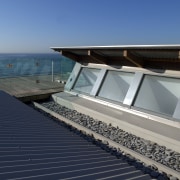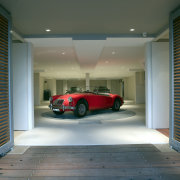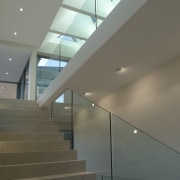Cool, calm and individual
A central courtyard each provides light and ventilation to these two adjacent apartments, while the interiors reflect the differing needs of potential residents

Modern design principles are often about keeping it green. One way to reduce the carbon footprint of a building is to create a design that reacts to the site's surrounding environment.
By responding to a seaside site, architect Geoff Ferris-Smith, from Dimidium Design Company, has created two self-contained, but adjacent, apartments with internal courtyards to allow natural light and ventilation. The entire building has been oriented to face due east, in order to take in the westerly sun in the evening, which makes the apartments warm in the winter, and cool in the summer.
"There is no air conditioning installed in these apartments. Instead, as warm air rises inside, cool air is drawn through the basement, then escapes through the courtyard, which acts as a tall funnel," says Ferris-Smith.
The courtyards are glazed and have operable louvres to allow air circulation. This, and the installation of skylights, means the homes are flooded with natural light.
The shared basement garage is 900mm below ground level and remains a constant 16ËC year-round. Designed to be a common area for both homes, it is highly finished, with a plaster ceiling and a car turntable that allows more efficient use of space than a traditional garage. Ferris-Smith says it is possible for this room to be used for entertaining.
"Each apartment has a wine cellar in the basement, and a guest suite or potential office with a balcony that faces the street."
By including a basement car park, the aesthetics of the street are not dominated by vehicles and garages. Reflecting the nearby sand dunes, the street entrance to the basement is by a recycled ironbark walkway, which is reminiscent of a boardwalk. Entry into the home is either from the garage level, or from the main entrance at the side of each apartment.
"The main entrance consists of a frameless glass enclosure, which provides protection from the weather, and allows visitors to be greeted by the view."
The first level of each apartment consists of the bedrooms and laundry, with the master suite situated at the front. The courtyard physically separates this area from the other bedrooms, allowing privacy.
Similarly, upstairs in the open-plan family, dining and kitchen areas, the courtyard provides some delineation between the spaces. The kitchen is linked to the other areas by a glazed walkway that travels over the courtyard. Louvred windows on the sides of this bridge can be left open to allow for air circulation, or closed in cold weather. The entire walkway can also be closed off.
When the weather is warm, a shared terrace on the rooftop provides space to enjoy the sun and the view over the beach. A concealed staircase released from the ceiling in the living area gives access to this terrace.
"Depending on the residents, the terrace can also be divided by a removable panel," says the architect.
Being so close to the ocean has necessitated the use of durable materials. Glazing throughout has a permanent bonded Enduroshield protective coating, and the rendered brick exterior is painted with a Murobond Paint system and sealant, which also has a refined aesthetic.
While the two apartments have the same basic design, Ferris-Smith says they provide an example of Dimidium's understanding of the design needs of different markets, as well as its ability to cater to the specifications of individual homeowners. The northern apartment was built especially for a young family, while the other was aimed at the executive market.

"Looking at the staircases in the two homes, there is a difference between the warmth and softness of the recycled timber used in the family's apartment, and the contemporary nature of the polished concrete used in the other. Under-floor heating is installed for comfort in the southern apartment."
Construction was carried out by Abuild Pro. The company was chosen for its experience in high-end residential projects, and for its ability to execute a detailed architectural brief, says Ferris-Smith.
For information, contact Dimidium Design, phone (02) 9267 0001. Email: geoff.ferrissmith@dimidium.com.au. Web: www.dimidium.com.au.
Enduroshield: Origen Australia, phone (02) 9639 7167, 0405 536 436. Email: choward@origenaustralia.com. Web: www.origenaustralia.com.
Abuild Pro: phone (02) 9363 4227. Email: info@abuildpro.com.au. Or view the website: www.abuildpro.com.au.
Story by: Trendsideas
Home kitchen bathroom commercial design
Connected to the ocean
Masculine meets mixed use
Contrast and connection











